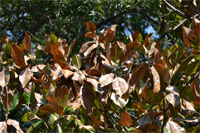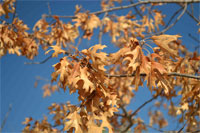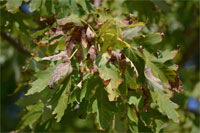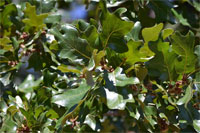Texas Tree Tips – January, 2012
Heat, Drought, and Trees
Given the recent drought and associated water restrictions, important questions arise: How do drought and heat affect plants? How do you water and care for plants during an extended drought and the resulting water restrictions? Before we can discuss watering plants, it is important to look at how they are affected by heat and drought.
Since tree roots in an urban landscape are intertwined with the roots of other nearby plants, a discussion about watering and care should include all the elements of the landscape as an integral ecosystem. For the sake of brevity, let’s consider trees, shrubs, groundcovers, and turf to be covered by one term: plants.

Although it has been adequately watered, this Southern magnolia’s foliage has browned from excessive heat. All photos courtesy of Bill Seaman.

The sudden onset of brown foliage on this Shumard red oak is attributed to both lack of irrigation and heat stress.

Silver maples are not adapted to extreme heat. In spite of sufficient irrigation, leaves curl and turn brown from consistently high temperatures.

While this post oak has not received irrigation or rainfall for three months, it is clearly unaffected and shows healthy new bud growth.
How does drought affect plants?
• On non-irrigated sites, drought, or the lack of rainfall, causes the loss of smaller feeder roots in the upper levels of the soil as moisture evaporates. If drought conditions continue, roots at deeper soil levels are lost. As soils lose more moisture to evaporation at the surface, they shrink by volume — which causes heaving and cracking. Shrinking soils can cause physical injury to the root systems of all plants.
• Smaller plants can be affected immediately as the top few inches of soil become dry. It can take years for the full effects of drought to be apparent in larger plants. Leaves of affected plants turn brown beginning at the edges. As the browning moves toward the center of the leaves, the plant expresses a scorched look. In some cases, primarily in large shrubs and trees, there is not a gradual burning of foliage, but rather a sudden onset of browning on all the leaves. Trees that may appear healthy can turn brown very quickly many years after a drought. In Colorado, aspens, Populus tremuloides, are currently dying in great numbers. Their loss is attributed to the drought from 2000 to 2004.
• If a disease, insects, or cultural conditions are an existing problem before the drought occurs, plants are more likely to be affected to a greater degree.
How does heat affect plants?
• On both irrigated and non-irrigated sites, extended periods of heat slow the biological function of plants. The effect occurs when daytime temperatures are over 95 degrees, regardless of the amount of moisture in the soil.
• Extreme soil temperatures also slow biological function. In 2011, there was a record number of days with nighttime temperatures never dropping below 85 degrees. No nights over 85 degrees were recorded during the previous heat wave of 1980. The loss of biological function is why plants, even on irrigated sites, were negatively affected in 2011. Watering does not shield plants from heat damage.
• Some plant species are more prone to heat damage than others are. For example, silver maple, Acer saccharinum, is not heat tolerant, while post oak, Quercus stellata, is unaffected.
• Increased air temperatures add to air pollution, affecting plant health. Studies show that tree health is affected by air pollution. I suspect that the same is true for all plants.
Unfortunately, the recent extended period of heat and the drought on non-irrigated sites create the opportunity for insects and pathogens to wreak havoc on our plants for years to come. Since trees have an energy reserve, they can sustain some damage from insects or pathogens. Either they overcome the damage over time or they go belly-up.
The loss of trees around the state will have a direct impact on us in many ways. The loss of shade increases energy costs. The increased urban heat island effect diminishes our air quality. Neighborhoods will also lose a part of their quality of life, and the erosion of precious topsoil occurs with the loss of foliage.
On the bright side, we have a great opportunity to replace stressed trees with more drought- and heat-resistant plants, which minimizes the negative impacts to our environment. Heat- and drought-tolerant plants reduce water use and maintenance expenses. They are a much better long-term investment.
The best defense you have against drought and heat damage is an education that begins with recognizing the effects to your plants.
About the author: Steve Houser is a Dallas native with more than 30 years of experience as a consulting arborist and tree climber. He is the president of Arborilogical Services Inc., “The Experts Your Trees Deserve.” www.arborilogical.com.
